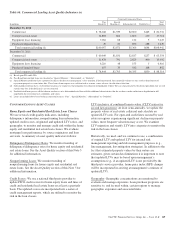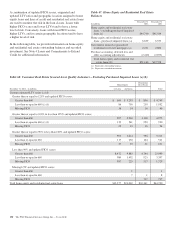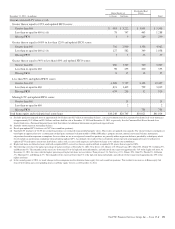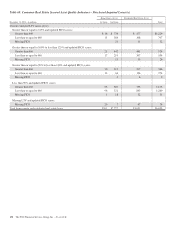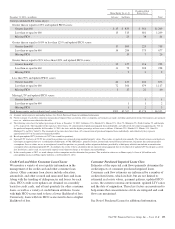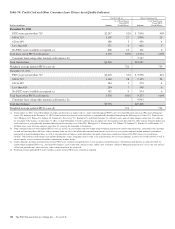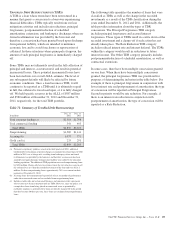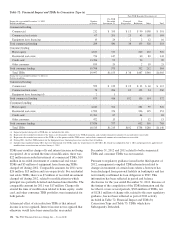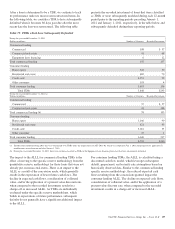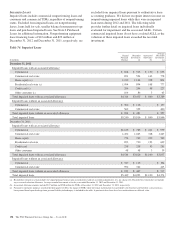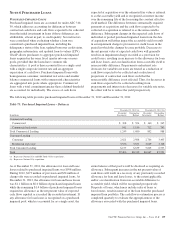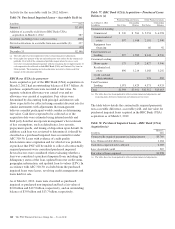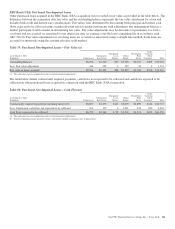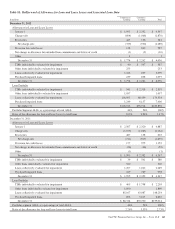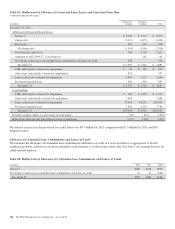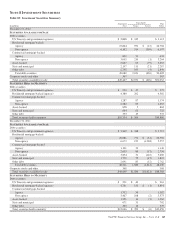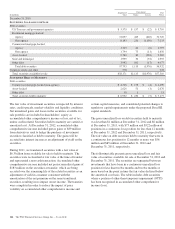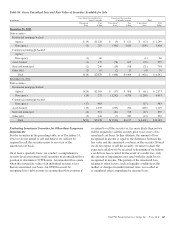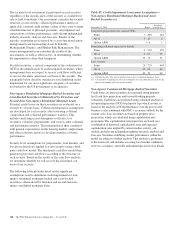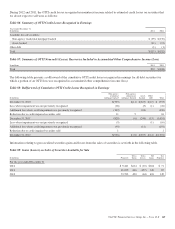PNC Bank 2012 Annual Report Download - page 178
Download and view the complete annual report
Please find page 178 of the 2012 PNC Bank annual report below. You can navigate through the pages in the report by either clicking on the pages listed below, or by using the keyword search tool below to find specific information within the annual report.
N
OTE
6P
URCHASED
L
OANS
P
URCHASED
I
MPAIRED
L
OANS
Purchased impaired loans are accounted for under ASC 310-
30, which addresses accounting for differences between
contractual cash flows and cash flows expected to be collected
from the initial investment in loans if those differences are
attributable, at least in part, to credit quality. Several factors
were considered when evaluating whether a loan was
considered a purchased impaired loan, including the
delinquency status of the loan, updated borrower credit status,
geographic information, and updated loan-to-values (LTV).
GAAP allows purchasers to aggregate purchased impaired
loans acquired in the same fiscal quarter into one or more
pools, provided that the loans have common risk
characteristics. A pool is then accounted for as a single asset
with a single composite interest rate and an aggregate
expectation of cash flows. Purchased impaired loans with
homogeneous consumer, residential real estate and smaller
balance commercial loans with common risk characteristics
are aggregated into pools where appropriate. Commercial
loans with a total commitment greater than a defined threshold
are accounted for individually. The excess of cash flows
expected at acquisition over the estimated fair value is referred
to as the accretable yield and is recognized as interest income
over the remaining life of the loan using the constant effective
yield method. The difference between contractually required
payments at acquisition and the cash flows expected to be
collected at acquisition is referred to as the nonaccretable
difference. Subsequent changes in the expected cash flows of
individual or pooled purchased impaired loans from the date
of acquisition will either impact the accretable yield or result
in an impairment charge to provision for credit losses in the
period in which the changes become probable. Decreases to
the net present value of expected cash flows will generally
result in an impairment charge recorded as a provision for
credit losses, resulting in an increase to the allowance for loan
and lease losses, and a reclassification from accretable yield to
nonaccretable difference. Prepayments and interest rate
decreases for variable rate notes are treated as a reduction of
cash flows expected to be collected and a reduction of
projections of contractual cash flows such that the
nonaccretable difference is not affected. Thus, for decreases in
cash flows expected to be collected resulting from
prepayments and interest rate decreases for variable rate notes,
the effect will be to reduce the yield prospectively.
The following table provides purchased impaired loans at December 31, 2012 and December 31, 2011:
Table 75: Purchased Impaired Loans –Balances
December 31, 2012 (a) December 31, 2011 (b)
In millions
Recorded
Investment
Outstanding
Balance
Recorded
Investment
Outstanding
Balance
Commercial Lending
Commercial $ 308 $ 524 $ 140 $ 245
Commercial real estate 941 1,156 712 743
Total Commercial Lending 1,249 1,680 852 988
Consumer Lending
Consumer 2,621 2,988 2,766 3,405
Residential real estate 3,536 3,651 3,049 3,128
Total Consumer Lending 6,157 6,639 5,815 6,533
Total $7,406 $8,319 $6,667 $7,521
(a) Represents National City and RBC Bank (USA) acquisitions.
(b) Represents National City acquisition.
As of December 31, 2011, the allowance for loan and lease
losses related to purchased impaired loans was $998 million.
During 2012, $173 million of provision and $74 million of
charge-offs were recorded on purchased impaired loans. At
December 31, 2012, the allowance for loan and lease losses
was $1.1 billion on $6.0 billion of purchased impaired loans
while the remaining $1.4 billion of purchased impaired loans
required no allowance as the net present value of expected
cash flows equaled or exceeded the recorded investment. If
any allowance for loan losses is recognized on a purchased
impaired pool, which is accounted for as a single asset, the
entire balance of that pool would be disclosed as requiring an
allowance. Subsequent increases in the net present value of
cash flows will result in a recovery of any previously recorded
allowance for loan and lease losses, to the extent applicable,
and/or a reclassification from non-accretable difference to
accretable yield, which will be recognized prospectively.
Disposals of loans, which may include sales of loans or
foreclosures, result in removal of the loan from the purchased
impaired loan portfolio. The cash flow re-estimation process is
completed quarterly to evaluate the appropriateness of the
allowance associated with the purchased impaired loans.
The PNC Financial Services Group, Inc. – Form 10-K 159


